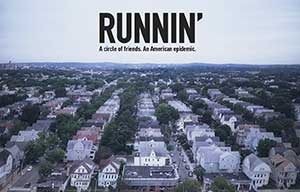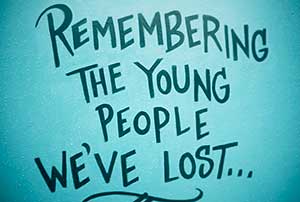
The documentary “Runnin’” provides an unfiltered view of the opioid crisis and the toll it has taken in the lives of many Somerville victims. — Photo courtesy of STAT
By Ian Erlichman
A scrappy looking man, with a weathered face and ice blue eye, sits in a collapsible chair in a furniture-less warehouse. His name is Marky Pantanella, and he was an opioid addict. Like many of his kind, now with a shrunken circle of childhood friends. “I feel like I’m the last man standing,” he remarked to the camera. Pantanella is featured in a film called Runnin’, directed by his childhood friend, and STAT journalist, Alex Hogan.
The documentary’s aim was to use Somerville as a case study in an investigation of America’s opioid epidemic. “By seeing what happened there, we can understand how it happened everywhere,” said Hogan. Much like the rest of the country, the epidemic started in the 1990’s with a prescription drug called OxyContin. Manufactured by Purdue Pharmaceutical, OxyContin was “marketed aggressively and dishonestly,” said Hogan.
Purdue tried to convince doctors that “opioids were non-addictive and that they weren’t harmful,” Hogan said. “Now we know, obviously, that that’s not the case.”
Addiction to OxyContin was accelerated because of both its availability and its relative youth in the recreational drug scene. “It was very easy to get your hands on it. Easier than alcohol and marijuana, in high school,” said Somerville firefighter Mike Curtis, during a film interview. “Now, people know what OxyContin is. When I was a kid, no one did,” remembers Hogan.
After OxyContin, or OCs, hit the streets, the black-market demand for them exploded. To satiate this demand, addicts would rob pharmacies for OxyContin. “I feel like every other week you would read that another CVS got robbed,” recalled Hogan.
Pharmacies stopped stocking OCs because of the inherent risk of having them, which further increased OxyContin’s black-market demand.
In an attempt to stop Oxycontin’s recreational abuse, another formulation was made “so you couldn’t crush it and snort it,” said Hogan. “As it got harder to get, people switched to heroin.”
“It’s a lot cheaper, a lot easier to get, and a lot more dangerous.”
 According to Hogan, the switch to heroin peaked in the mid-2000s and soon, society started to feel the effects. According to the Department of Justice, nation-wide heroin overdoses jumped from three thousand in 2010 to nearly thirteen thousand in 2015.
According to Hogan, the switch to heroin peaked in the mid-2000s and soon, society started to feel the effects. According to the Department of Justice, nation-wide heroin overdoses jumped from three thousand in 2010 to nearly thirteen thousand in 2015.
During this span, opioids claimed the lives of two of Hogan’s childhood friends, Alex Foster and Kevin Sullivan.
“Recently,” Hogan said, “it not even heroin anymore, its synthetic opioids.” Addicts are switching to primarily a synthetic opioid called fentanyl because you need less of it for the same effects explains Hogan. Fentanyl can be even deadlier than heroin because of it potency, which according to the National Institute on Drug Abuse is anywhere from 50 to 100 times that of heroin.
According to Hogan, amounts of Fentanyl “the size of grains of salt,” can mean the difference between an ordinary high and an overdose. Data from the Center for Disease Control reflects this, reporting that fentanyl related overdoses spiked by over 70 percent from July 2016 to July 2017.
The good news is that the people of Somerville are fighting back. Among them are the parents of the late Alex Foster, who founded the Alex Foster Foundation to educate the public about the dangers of opioid addiction.
According to Hogan, that scrappy looking man, Marky Pantanella is “doing great” and recently landed a job at a local gas station.
You can watch Runnin’ at www.statnews.com/2018/05/22/runnin-new-documentary-stat and donate to the Alex Foster Foundation at www.aff-soar.org.
If you or someone you know is abusing opioids, please contact the Massachusetts Substance Abuse Hotline at (800)327-5050.













Reader Comments